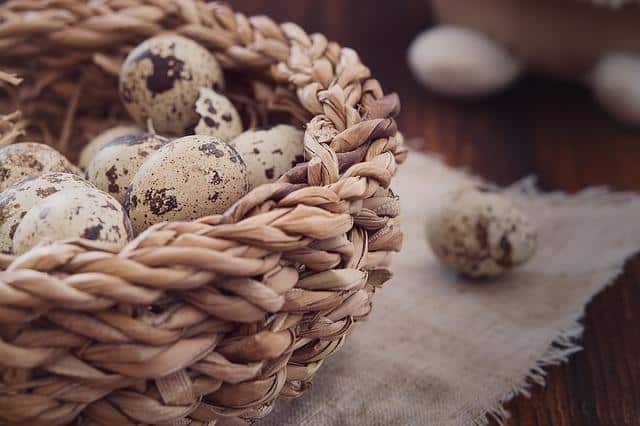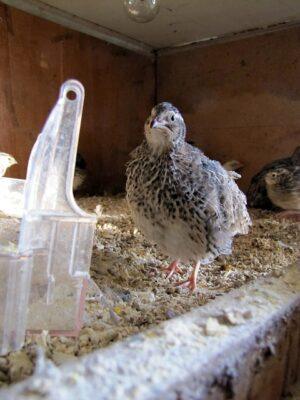Keeping backyard chickens is a great way to begin your journey toward self-sufficiency, but the term “backyard chickens” implies that you have a backyard. What if you’re living in a small apartment, hoping perhaps one day to move to land, but wishing you could get experience to try your hand at it before you commit?
Quail are a great and easy way to get started with poultry and experience the independence of raising your own eggs and meat, without the need for anything more than a small bit of indoor space. Simple rabbit hutches with wire floors and solid trays beneath make excellent quail housing, and can be kept indoors anywhere you could keep either rabbits or a domestic bird such as a parakeet. There’s even the occasional story of a country farm kid keeping quail in their college dorm room because they missed the fresh eggs and company of poultry.
Housing & Space Requirements
Quail are very small animals, and the average bird is only 3.5 to 5.5 ounces (roughly 1/4 pound) and about five inches tall, though some commercial meat breeds can be as heavy as 12 ounces (3/4 pound). They’re mostly a ground foraging bird, and need floor space rather than high ceilings, which makes short but wide floored rabbit hutches an excellent housing choice. Shorter cages are actually preferred, as the low roof keeps them from trying to fly when startled, with may result in injury.
Wire floored cages with removable trays beneath are generally preferred because the droppings fall through the wire, keeping the quail clean and healthy. On solid floors, quail tend to stand in their feces and often eat them, spreading disease and parasites. To keep quail feet healthy, use no more than ¼-inch square wire for the floor. Quail are also often reluctant to use nesting boxes, so wire floors make it easier to find the eggs and keep them clean than with solid floors and bedding.
Diatomaceous Earth: The All-Natural Livestock De-Wormer
As a general rule, each quail needs 1 square foot of floor space, and should be kept at a ratio of 4-5 females to each male. Some people choose to keep their quail in lower ratios in smaller cages, and will put 3 females with 1 male in a standard 18 x 24-inch rabbit cage without issue. Keep in mind that at least 1 square foot is ideal, and smaller conditions could lead to stress for your birds.
Life Cycle
Quail egg incubation varies based on breed, but the most popular breed, the Coturnix, incubates for 16-18 days. Once hatched, the chicks reach maturity for meat or to begin laying eggs at 6-10 weeks. This compares to 21 incubation days for chicken eggs and no eggs laid until roughly 20 weeks. That means that your female quail will be laying for as many as 12 weeks while a chicken started at the same time is still growing and maturing.
It’s easy to see how they could be quickly reproduced to yield a large flock from just a small number of initial hatching eggs, with only roughly 12 weeks between generations.
Quail tend to live 2-4 years and can produce 200-250 eggs per year.
Feeding Quail
Quail are not common enough to have their own commercial food mix, but their nutritional requirements are similar to turkeys. They’re commonly fed turkey feed based on their life stage. Adult quail only need about 15-20 grams of food per day. Quail keepers commonly supplement their feed with small seeds (flax, etc.) and leafy greens to improve the nutritional quality of the eggs and encourage good health in the flock.
Egg Production
Quail tend to lay eggs at roughly the same rate as a heritage breed chicken, producing as many as 250 eggs per year starting at 6-10 weeks of age. They require 14-16 hours of daylight per day to lay, which is easy to provide indoors. While the main benefit of quail is the small size, which allows them to be kept indoors, it also means that their eggs are very small. It takes 5 quail eggs to equal 1 chicken egg in volume, although quail eggs are slightly more nutritious. Still, quail eggs peel easy as hard boiled eggs and make adorable deviled eggs or fried eggs on top of hamburger sliders. What they lack in size you’ll have to make up for in culinary creativity.
Meat Production
Quail dress out at roughly 75 percent of their live weight, and the yield will depend on the size and breed of your original bird. Though they’re more attractive roasted with skin on, plucking is very time-consuming for the amount of meat produced; for small-scale home consumption it’s generally recommended to skin the birds rather than pluck them. Since they’re so small, a single serving is generally considered to be 2 birds per person. This may seem like a lot, but remember that they only take 6-8 weeks to reach harvesting size, meaning that even incubating eggs in small batches you’ll have plenty of meals.
Have you ever owned quail? Share your tips on raising them in the section below:
 Off The Grid News Better Ideas For Off The Grid Living
Off The Grid News Better Ideas For Off The Grid Living






